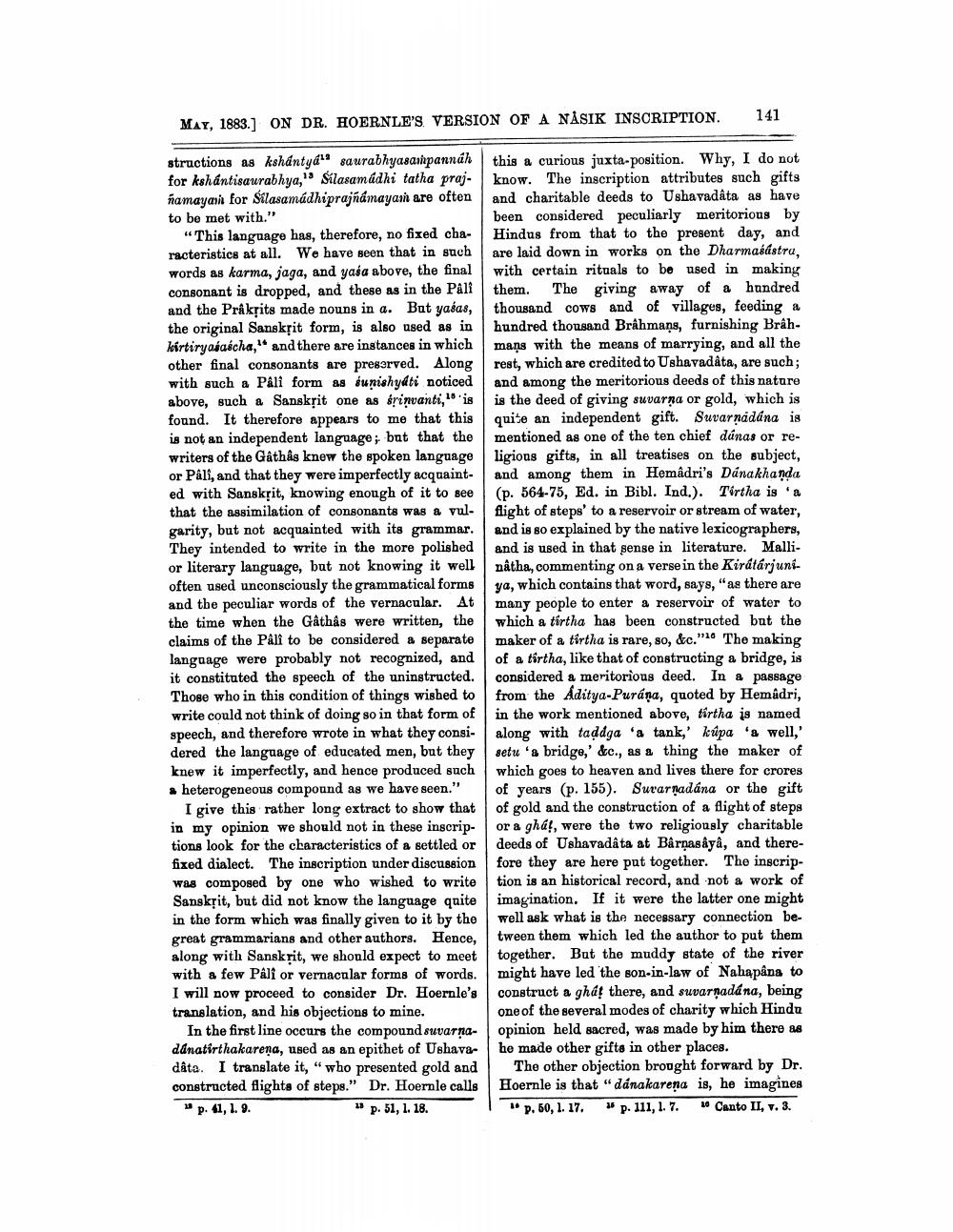________________
MAY, 1883.] ON DR. HOERNLE'S VERSION OF A NÅSIK INSCRIPTION.
141
structions as kshantya" saurabhyasampannáh for kshäntisaurabhya, Silasamadhi tatha praj- namayari for Silasamadhiprajnámayain are often to be met with."
"This language has, therefore, no fixed cha- racteristics at all. We have seen that in such words as karma, jaga, and yasa above, the final consonant is dropped, and these as in the Pali and the Pråkțits made nouns in a. But yasas, the original Sanskțit form, is also used as in kirtiryababcha," and there are instances in which other final consonants are preserved. Along with such a Páli form as surishyati noticed above, such a Sanskrit one as brinvanti, 1.is found. It therefore appears to me that this is not an independent language; but that the writers of the Gathâs knew the spoken language or Páli, and that they were imperfectly acquainted with Sanskrit, knowing enough of it to see that the assimilation of consonants was & vul. garity, but not acquainted with its grammar. They intended to write in the more polished or literary language, but not knowing it well often used unconsciously the grammatical forms and the peculiar words of the vernacular. At the time when the Gâthâs were written, the claims of the Půli to be considered a separate language were probably not recognized, and it constituted the speech of the uninstructed. Those who in this condition of things wished to write could not think of doing so in that form of speech, and therefore wrote in what they consi- dered the language of educated men, but they knew it imperfectly, and hence produced such heterogeneous compound as we have seen."
I give this rather long extract to show that in my opinion we should not in these inscriptions look for the characteristics of a settled or fixed dialect. The inscription under discussion was composed by one who wished to write Sanskpit, but did not know the language quite in the form which was finally given to it by the great grammarians and other authors. Hence, along with Sanskrit, we should expect to meet with a few Páli or vernacular forms of words. I will now proceed to consider Dr. Hoernle's translation, and his objections to mine.
In the first line occurs the compound suvarnadánatirthakarena, used as an epithet of Ushavadâto. I translate it," who presented gold and constructed flights of steps." Dr. Hoernle calls p. 41, 1. 9.
p. 51, 1. 18.
this a curious juxta-position. Why, I do not know. The inscription attributes such gifts and charitable deeds to Ushavadâta as have been considered peculiarly meritorious by Hindus from that to the present day, and are laid down in works on the Dharmaśdstru, with certain rituals to be used in making them. The giving away of a hundred thousand cows and of villages, feeding a hundred thousand Brahmans, furnishing Bråhmans with the means of marrying, and all the rest, which are credited to Ushavadâta, are such; and among the meritorious deeds of this nature is the deed of giving suvarna or gold, which is quite an independent gift. Suvarnadána is mentioned as one of the ten chief dúnas or religious gifts, in all treatises on the subject, and among them in Hemâdri's Dánakhanda (p. 564-75, Ed. in Bibl. Ind.). Tirtha is a flight of steps' to a reservoir or stream of water, and is so explained by the native lexicographers, and is used in that sense in literature. Mallinátha, commenting on a verse in the Kirátárjuniya, which contains that word, says, "as there are many people to enter a reservoir of water to which a tirtha has been constructed but the maker of a tirtha is rare, so, &c." The making of a tirtha, like that of constructing a bridge, is considered a meritorious deed. In a passage from the Aditya-Purána, quoted by Hemûdri, in the work mentioned above, tirtha įg named along with tadga 'a tank, kúpa '& well, setu 'abridge,' &c., as a thing the maker of which goes to heaven and lives there for crores of years (p. 155) Surarnadána or the gift of gold and the construction of a flight of steps or a ghal, were the two religiously charitable deeds of Ushavadâta at Bârņasåyå, and therefore they are here put together. The inscription is an historical record, and not a work of imagination. If it were the latter one might well ask what is the necessary connection between them which led the author to put them together. But the muddy state of the river might have led the son-in-law of Nahapana to construct a ghat there, and suvarnadána, being one of the several modes of charity which Hindu opinion held sacred, was made by him there as he made other gifts in other places.
the other objection brought forward by Dr. Hoernle is that "dánakarena is, he imagines "p. 60, 1. 17. p. 111, 1. 7. Canto II, v. 3.




